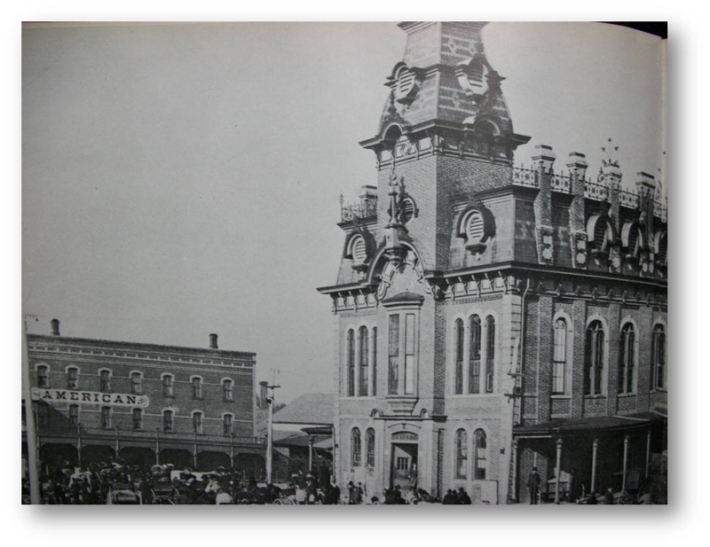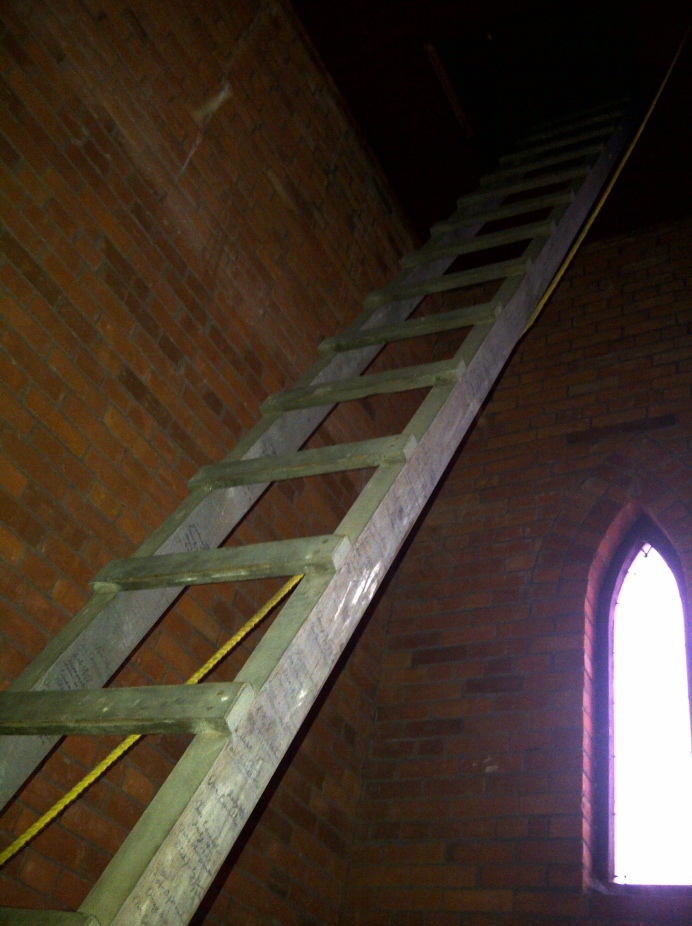Over the past 150 years here in Canada the penetrating, vibrant ringing of church bells have sounded in large cities right down to small villages. And for centuries in Europe, church bells have played a prominent role in the history of countries, communities, and places of worship. Church bells are the biggest and loudest musical instruments in the world. Enclosed in their prominent landmark towers, their sound can be heard miles away. These bells were rung to call people to church, to celebrate happy occasions and to commemorate important events. Church bells have been known and recognised as local fixtures that represent the enduring quality of community.

Hillsdale Presbyterian church with the bell tower on the right.
Bells were the common folks timepieces for many people up to the early part of the 1900’s. Clocks and watches were precision instruments that were made by hand and required a multitude of moving parts. And they were quite expensive. I received my 1st and only mechanical wristwatch for my grade 8 graduation in 1973 when I was 13. It was a very basic watch, but my parents paid around $25, which was a huge amount of money back even in the 1970’s when watches were becoming more common. This was an era when you could buy a candy bar for 5 cents, a soft drink for 10 cents. And gasoline was 30 cents per Imperial gallon, (which is 7 cents per litre). To put watches into perspective to today, I needed a very basic watch for my work and I ended up buying one a couple of weeks ago at the dollar store with todays microprocessor and button cell technology. My cost with taxes was just over 4 dollars.

Many Canadian town and city halls had bell towers, such as this one in Barrie (the city where I work). Photo from the 1880’s Image Source
For those who could not afford watches or clocks in those early days, civic buildings had bells that rung every hour. Church bells rang to remind people that worship would be happening soon. On ships, bells were rung every 30 minutes for the crews working onboard. Very interesting that their four hour shift is called a “WATCH” as sailors performed essential activities such as manning the helm, navigating, trimming sails and keeping a lookout. Sadly there is one other Canadian landmark which is now only a part of bell history. Many of their bells are now forever silent. They are the one room schoolhouses which at one time dotted our countryside. Some schools did not have them, but most did. They had a bell to announce that classes were going to start soon. I missed the one room schoolhouse by one year, but my older brother and sister had that experience. They had to walk two miles to get to their school at a place called Clowes, (which is no longer found on a map). When the bell rang, it indicated classes were to begin in 15 minutes. And if they were still more than a mile away, they had to really pick up their pace in order to get there on time.

Took this photo on a recent bike trip, this is Carley Community Hall. It’s website mentions it was built as a functioning 1 room schoolhouse in 1912, and is now used as a community hall. Love how it maintains that glorious heritage décor (bell and all).
Much like mechanical watches, the old brass bells and the rope mechanism that drives them are pretty much obsolete these days. I imagine there are very few foundries around anymore that would manufacture (a term called bellfounding) those brass bells and mechanisms. There are electronic bell systems nowadays that are so authentic, you cannot tell the difference between a bronze brass bell and an electronically produced bell sound. Electronic bells are much cheaper and far less expensive to maintain than the traditional brass bell and ringing mechanism.

King George V and Queen Mary in photo dated 1919 (a year after World War 1 ended) at Britain’s Whitechapel Bell Foundry. Guinness Book of Records listed it as Britain’s oldest running manufacturing company. Established in 1570, it closed in May 2017 putting that record to an sad end. This is the foundry that manufactured London’s “Big Ben” bell. Big Ben remained silent for the entire Great War, and was tolled again in jubilation once news broke out that the Great War (World War 1) was over. Image Source
It is an honour to be a lay pastor at a church that still has a working mechanical brass bell in the belfry. It is a swinging bell, engaged manually using a 2 inch thick rope that goes up from the bell tower below. Pulling on the rope engages a wheel which pulls the bell up. As the bell drops back down, the downward momentum of the bell causes a clapper to strike against the bell sending out that rich, vibrant sound.

Rope which goes up from the bell tower room into the church belfry. When pulled the bell is tolled.
This Sunday November 11th, 2018 at 5:00 pm. that old brass mechanical bell at Hillsdale Presbyterian Church will be tolled 100 times as part of a larger audible and moving reminder across the country of Canada marking the 100th anniversary of the end of the 1st World War. When that Great War finally ended there was a huge relief and celebration, and there were bells tolling all around the globe. In a Toronto Sun article, it mentions that back on November 11, 1918 when news of the end of the war broke, Canadian churches spontaneously rang their bells.

Old newspaper declaring the end of the First World War. Image Source
The initiative is the Royal Canadian Legion Veteran Affairs Bells of Peace campaign. This will see legion branches, churches, municipal buildings and naval ships ringing their bells 100 times. Beginning at St. John’s Newfoundland, and ending on Vancouver Island, British Columbia as the sun sets on different time zones across the country.

Flyer for the Bells for Peace at the Hillsdale church, an initiative that will see many hundreds of legions, churches, municipal buildings and naval ships ringing their bells across the country. When you hear the bell toll, please remember to take a moment to pause and remember all those who served and sacrificed.
Ringing that bell will be a reminder that ordinary people just like you and me served and gave their lives for our freedom. The bell tower of the church itself is a time capsule of names and dates that have been written on the long ladder leading up out of the bell tower into the belfry. It is hard getting my mind around the fact I will be ringing that very same bell just like someone else did 100 years ago celebrating the end of the 1st World War. Ringing those Bells of Peace will honour the more than 66,000 Canadians killed and the more than 172,000 Canadians wounded in the First World War. Ten percent of Canadians who fought in this war did not return. Words cannot express how grateful I am for such a great sacrifice.

Climbing the ladder into the church belfry is not for the faint of heart, but certainly nothing compared with what our troops have endured. The ladder is like a time capsule with names and dates, a few that predate the Great War.

Description with this photo reads as follows from ww1.canada.com website..”Life in the trenches was brutal. The threat of sudden death was constant. Rats were everywhere, grown to massive size from feasting on corpses. Clothes were infested with vermin. Soldiers were exposed to the elements and extremes of temperature and mud clung to everything”. (If I were in my 20’s or 30’s 100 years ago, this could easily have been me in those trenches).

Poster to encourage Canadians to enlist for World War 1. Image Source
Our freedom we enjoy does not come lightly. From the 1st and 2nd World Wars, the Korean War, and modern day conflicts such as Afghanistan, and those who are currently serving in the military there was and is a huge sacrifice paid for the freedom we now have. #LestWeForget




Cool history Carl on the church bells and their particular significance in honoring soldiers. God bless them and the sacrifices they made to keep us are today.
Hope all is well with you Carl! 🙂
LikeLiked by 1 person
Thank you Tricia for reading and for sharing your touching comment. Such great sacrifices, not only in Canada, but so many countries around the world. Yes all is well with me. Hope all is the same with your self! 🙂
LikeLiked by 1 person
All is well here to Carl, thanks! 🙂
LikeLiked by 1 person
Pingback: Running (a little late) Into 2023 – theoldfellowgoesrunning
Pingback: The War Story | My Sunday Blog